Class of classes
His reputation has taken a hit and his integrity has been called into question – again.
Still, despite allegations of major NCAA rules violations that occurred under his watch at Memphis, embattled coach John Calipari will be back on the bench this fall.
Only now he's at Kentucky, where the future appears bright enough to blind those peering into Calipari's past.
The reason for the optimism: John Wall – as well as DeMarcus Cousins, Eric Bledsoe, Daniel Orton, Darnell Dodson and Jon Hood. The group forms what is far and away the best recruiting class of 2009.
And, some say, ever.
"In recent contemporary college basketball history, The Fab Five at Michigan has always been the standard bearer for recruiting," said Jerry Meyer, a recruiting analyst for Rivals.com. "This Kentucky class matches it – or surpasses it.
"We may never have seen a class this good."
Indeed, Wall, a point guard, is the top-ranked prospect in the country and the likely No. 1 pick in next year's NBA draft. The 6-foot-9 Cousins is ranked No. 2 while Orton (22) and Bledsoe (23) are also in the top 25.
Hood is a shooting guard who was recently named Mr. Kentucky Basketball. Dodson, a small forward, was one of the most sought-after junior college recruits in the nation.
If the class remains intact – Wall, Cousins and Bledsoe have yet to qualify academically – the debate over this group's place in history will undoubtedly linger all season. In the meantime, here's a look at the five most-hyped recruiting classes of all time.
Another high five
Here's a look at five more classes worthy of being in the argument for "best recruiting class ever."
INDIANA, 1972
Bob Knight has always said that his first recruiting class at Indiana was his best. Quinn Buckner, Scott May and Bobby Wilkerson were among the Top 11 players selected in the NBA draft following their senior seasons. Another player from that class, Tom Abernethy, also played in the NBA. The class went 63-1 over its final two seasons at Indiana, including a 32-0 mark and an NCAA title in 1976.
NORTH CAROLINA STATE, 1971
Coach Norm Sloan added the key pieces to the Wolfpack's 1974 national championship squad by signing superstar David Thompson along with point guard Monte Towe and forward Tim Stoddard. The trio sat out the 1971-72 season – which marked the last season that freshmen were ineligible – before leading North Carolina State to glory two years later. Thompson, the No. 1 overall pick in the 1975 draft, played nine years in the pro ball (NBA, ABA). Stoddard, a pitcher, enjoyed a successful major league baseball career.
OHIO STATE, 2006
It wasn't quite The Fab Five, but Greg Oden and Mike Conley Jr. accomplished the same thing as Michigan's 1991 class by leading the Buckeyes to the NCAA title game as freshmen. Both players – along with sharpshooter Daequan Cook – entered the NBA draft after losing to Florida in the championship. Oden was the first overall pick while Conley and Cook also went in the first round. David Lighty was also a key member of that class. He is still on the Ohio State roster.
"I don't think anyone knew that Conley was going to be as good as he was," said Bob Hunter, a columnist at the Columbus Dispatch.
"Everyone knew he was good, but because he came with Oden, he was overshadowed. But Conley was the reason the team was really good. Oden got hurt and didn't play until the middle of December. All that while, Conley was the guy."
"Nobody thought Conley would go to the NBA after one year. But after NCAA tournament, his stock rose, and he couldn't afford not to go. It shows you how important a point guard is. If he was still there, Ohio State would be really, really strong."
FLORIDA, 2004
The Gators foursome of Corey Brewer, Al Horford, Joakim Noah and Taurean Green proved that rankings don't always mean everything. Not one of them was ranked on the Rivals.com Top 30 list, but they combined to lead Florida to back-to-back NCAA titles in 2006 and 2007.
All four players left school after their junior season. Horford (No. 3), Brewer (No. 7) and Brewer (No. 9) were selected in the top 10. Green was picked in the second round. Florida, meanwhile, has failed to make the tournament the past two seasons.
KANSAS, 1999
Drew Gooden, Kirk Hinrich and Nick Collison led the Jayhawks to the 2002 Final Four. Gooden left after that season and was the fourth overall pick in the NBA draft. Hinrich and Collison returned to spark KU to the 2003 national title game, where it lost to Syracuse. Hinrich was picked seventh in that summer's draft while Collison went at No. 14. Gooden (2002) and Collison (2003) were both consensus first-team All-Americans.
"It was the recruiting class that Roy Williams credits for saving his career," said Blair Kerkhoff of The Kansas City Star. "It was the class that kept him at Kansas instead of going to North Carolina the first time in 2000. History was re-written because of that class. He wasn't going to leave that group in 2000.
"It was maybe the most important class that RW ever recruited, based on where he was in his career and what had happened to him."
UCLA, 1965
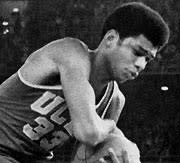
Lew Alcindor at UCLA.
(AP file photo)
It's hard to imagine a class having as successful of a run as the one led by Lew Alcindor, who later changed his name to Kareem Abdul-Jabbar. In those days players weren't allowed to compete until they were sophomores, but Alcindor still made his presence felt when he scored 51 points for his freshman team in a 75-60 victory over the No. 1-ranked varsity squad during a November exhibition game in the new Pauley Pavilion.
"Lew Alcindor strode onto the Pauley Pavilion court Saturday night and captured the town, completely demoralizing the UCLA varsity basketball team in the process," wrote Mal Florence of the Los Angeles Times.
Eventually Alcindor administered his beatings to less friendly opponents.
As a sophomore the following season Alcindor won his first of three consecutive NCAA titles at UCLA. He dunked so much that the shot was temporarily banned, and he was twice named National Player of the Year.
Still, it's not as if Alcindor was the only standout player in the 1965 recruiting class. Lucius Allen earned All-American honors and was the third overall pick in the 1969 NBA draft. Lynn Shackelford was a three-year starter at forward and guard Ken Heitz started as a freshman. Bill Sweek became a key contributor off the bench.
No one, though, dominated college basketball quite like Alcindor. More than 40 years later, that's still the case.
Michigan, 1991
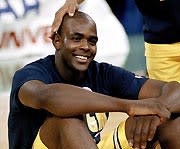
Chris Webber at Michigan.
(AP file photo)
As good as the 1965 class from UCLA may have been, it doesn't receive nearly the hype these days as "The Fab Five," which is considered by many to be the greatest class in history.
Chris Webber, Jalen Rose, Juwan Howard, Jimmy King and Ray Jackson all started as freshmen. They reached the NCAA national championship game two years in a row, losing to Duke in 1992 and North Carolina in 1993. The NCAA later stripped the precocious Wolverines of their Final Four appearances for Webber's involvement with booster Ed Martin.
"None of those guys knew what pressure was," said Larry Henry, the Wolverines' play-by-play voice from 1987-97. "They all thought they were the best."
Webber, Howard, Rose and King entered college as the nation's Nos. 1, 3, 6 and 9th-ranked players respectively. Jackson was ranked No. 84. The buzz about the class was non-stop from the moment they arrived on campus.
"They were on the cover of every newspaper and magazine in the country," Henry said. "The press was showing up to preseason practice because they couldn't wait to cover those guys.
"On the road it was like traveling with the Beatles. We went to Penn State and students were standing behind police barricades begging for autographs. I'm not sure we'll ever see anything like it again."
Although known for their black shoes and socks, shaved heads trash talk and long shorts – yes, they started that trend – The Fab Five will be equally be remembered for their cohesion on the court.
"It sounds corny, but they truly were 'all for one,'" Henry said. "They were the Three Musketeers, except there were five of them."
Kentucky, 2009
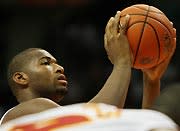
DeMarcus Cousins during the 2009 McDonald's All American game in April.
(Doug Benc/Getty Images)
One year after failing to make the NCAA tournament, the Wildcats will be ranked No. 1 in most preseason polls thanks to incoming class that's stocked with both talent and depth.
The leader of the group is Wall, a 6-foot-4 point guard who will be as fast with the ball as any player in the country. His presence will take some pressure off high-scoring shooting guard Jodie Meeks – if, of course, Meeks withdraws from the NBA draft and returns for his senior season.
Dodson should give Kentucky the high-scoring wing it's been missing for years, while Cousins will team with junior Patrick Patterson to form one of the most imposing frontcourts in the country. Bledsoe, a point guard, and Orton, a center, should provide ample help for a team that should run the SEC and then challenge Kansas for the NCAA title.
"If you compare Kentucky's class to other classes going into college, Kentucky is at the top," said Meyer, the recruiting analyst. "Making it even more remarkable is how quickly [Calipari] put this class together. From that standpoint, it's been a groundbreaking year. Nothing like that has ever happened."
Not that Calipari started from scratch.
Cousins and Dodson had planned to go to Memphis and then switched to Kentucky once Calipari was hired in Lexington. Wall, who was also leaning toward Memphis, followed suit by signing with the Wildcats. Orton and Hood were already on board, having signed with Kentucky and former coach Billy Gillispie during the fall.
Duke, 1997
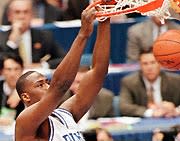
Elton Brand at Duke.
(AP Photo/Bill Kostroun)
Landing the No. 1-ranked prospect in the country is one thing. Signing three of them is another. That's what happened at Duke in 1997, when Shane Battier, Elton Brand and Chris Burgess committed to the Blue Devils.
Each player had been ranked No. 1 by various recruiting services.
"That class produced two Final Four teams and a national championship," said Al Featherston, who has covered Duke and the ACC for various media outlets for decades. "It would've been hard for them to do much better then they did [in 1997]."
Especially considering the haul also included standout guard William Avery, who was selected in the first round (14th overall) of the NBA draft after his sophomore season.
Still, as good as Avery was, Brand and Battier were the stars of the class. Brand entered the NBA draft after his sophomore season and was the first overall pick. Battier stayed all four years, leading the Blue Devils to the 2001 national title before becoming the sixth overall pick in the draft.
The player who never panned out was Burgess, who transferred to Utah after two seasons. After battling through injuries, Burgess averaged 13.2 points as a senior.
As good as the 1997 class may have been, there are those who believe the Blue Devils' 1999 signees – Jason Williams, Mike Dunleavy and Carlos Boozer – were even better.
North Carolina, 2006
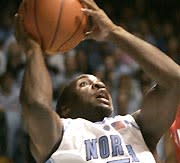
Ty Lawson at North Carolina.
(AP Photo/Karl DeBlaker)
Even after capturing his first NCAA title in 2005, Roy Williams still had detractors. Most of the standouts on that team – Raymond Felton, Sean May and Rashad McCants – had been recruited by former coach Matt Doherty.
"Fair or not," Featherston said, "there were still people who said Roy couldn't win the big one with 'his' players."
Thanks to the Tar Heels' Class of 2006, that opinion no longer exists.
Players such as Ty Lawson, Wayne Ellington and Deon Thompson helped Williams win his second title with a convincing victory over Michigan State in April. For most of the season North Carolina was on a completely different level than its opponents – especially when it mattered most.
"Everyone knew it was going to be a strong class right off the bat," said Bill Cole, who covers the Tar Heels for the Winston-Salem Journal. "But I'm not sure anyone was ready to call it the best in school history or anything. No one really thought it would end up this way."
Especially after the crown jewel of the group, Brandan Wright, entered the NBA draft – he was the eighth overall pick – after helping North Carolina reach the NCAA Regional finals as a freshman. Even though Wright didn't make a long-lasting impact on the program, his signing was a signal of things to come.
"It was one of the few times since Dean Smith retired that North Carolina went head-to-head with Duke for a recruit and won," Cole said. "It was a key acquisition and, in some ways, a turning point."
Another high-profile member of the class, Alec Stephenson, transferred to USC after two seasons. Lawson and Ellington almost entered the NBA draft, but they eventually withdrew their names and returned to lead the Tar Heels to the 2009 national title. It was their second straight Final Four appearance. Thompson was also a starter on the championship squad.
